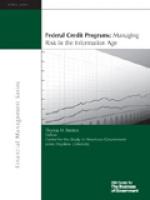
Federal Credit Programs: Managing Risk in the Information Age

This report highlights the fundamental tensions that federal credit programs face between doing good and doing well. On the one hand, the government provides support through loans and loan guarantees to borrowers who are not considered adequately served by commercial credit markets. On the other hand, the government cannot afford to lose large amounts of money by paying for an unacceptable number of defaults on federal loans. The report concludes with 10 recommendations for federal credit agencies, as well as several core lessons from research conducted for the study: (1) federal credit agencies must establish management information systems and risk monitoring systems; (2) the availability of positive models shows that this can be done; (3) effective risk management also requires processes to allow senior managers to review relevant information and take action to deal with emerging risks; and (4) a sound statutory framework is needed to help many credit programs succeed. The report also includes case studies of promising practices in risk management. Stanton concludes that federal credit programs have much to teach one another. education, export import bank, hud, housing and urban development, sba, small business administration Financial Management



